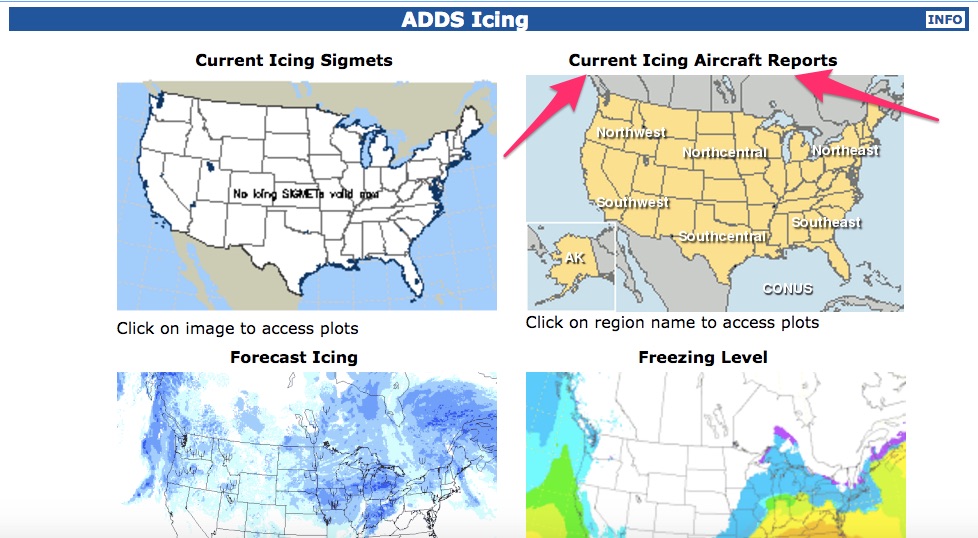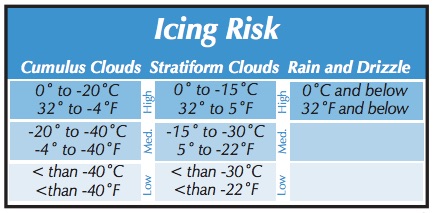
Icing is a serious problem regardless of your aircraft’s capability. Because it’s so important for the safety of flight, it’s vital pilots report icing as often as they can to assist other pilots.
Why report icing?
Forecasters do their best, but pilot reports are invaluable to verify forecast conditions. Without PIREPS, all we have to go on are the forecasted freezing level and the ceiling reports. But freezing levels are only a best guess.
The Aviation Weather Center does an excellent job of collecting icing PIREPs. Here is a screenshot of where to go for PIREPs:

You are actually required to report any un-forecasted hazardous weather. This will alert the national weather service forecasters to re-issue their forecasts. They can and often will issue SIGMETs and AIRMETs off PIREPS.
Planning an IFR flight with an aircraft not certified for ice can be extremely challenging without PIREPs.
We normally turn on de-ice and anti-ice equipment at 5 degrees C and any visible moisture. So, non-certified aircraft have to limit themselves to flights below 5 degrees C (usually…you could probably push it to 2 degrees).
But temps below 5 degrees and visible moisture don’t guarantee the presence of icing. Only a PIREP can confirm icing. You may really help someone out if you can confirm there isn’t any icing in the clouds at 5 degrees.
Side Note: icing at certain temperatures depends on the cloud type.
Check out this chart from AOPA’s icing guide with various types of cloud types and temperatures you will most likely see icing:

Hopefully, I’ve convinced you to report often. But, now for the hard part.
How do you determine the severity of icing?
When I first started flying in icing, I thought trace, light, moderate, and severe icing was defined by the amount of ice on the aircraft.
It is not.
Icing intensity is defined by the rate at which ice accumulates.
The AIM (7-1-20) defines icing rates as follows: (I will paraphrase to make it easier to understand)
Trace: Ice becomes perceptible. You don’t need to use deicing/anti-icing equipment unless you hang out in the trace icing for an extended period of time (over an hour).
Light: The rate of accumulation may create a problem if you hang out in it for over an hour. You may occasionally use deicing/anti-icing equipment to remove or prevent the accumulation. Your systems are capable of handling it.
Moderate: The rate of accumulation is such that even short encounters become potentially hazardous. You have to use your deicing/anti-icing equipment frequently because if you didn’t you would need to exit the icing immediately.
Severe: the rate of accumulation is such that ice protection systems fail to remove the accumulation of ice. Or, the ice is so bad it is on surfaces where you don’t normally see icing like aft of the protected surfaces (ie. past the de-ice boots or all over the spinner). Immediately exit from the conditions.
Note from AIM: “severe icing is aircraft dependent, as are other categories of icing intensity. Severe icing may occur at any accumulation rate.”
How do you know what type of ice is on your wings?
Great question. I wrote an article called: “What are the Four Types of Aircraft Ice.” Click on the link to read.
How do you give an icing PIREP?
First of all, relax. It’s not a big deal to give a PIREP! The report doesn’t have to be perfect. Far from it!
You should give them any time you think a pilot doing pre-flight planning would really need that information (icing, low ceiling, bad and good visibility, cloud tops etc)
Once you have determined the level of icing for your type of aircraft (don’t worry about other aircraft types), then the format goes like this:
- Aircraft identification
- Location
- Time in UTC (this usually only applies if you didn’t have time and relayed the report later)
- Intensity and type
- Altitude/Flight Level
- Aircraft type (if you prefaced your call sign with your a/c type then leave this out)
- Outside air temp
This report seems intimidating, doesn’t it? Please, don’t worry! Actual weather icing weather reports go like this:
- Aircraft ID/call sign
- Intensity and type
- Altitude
- Outside air temp
And they usually sound something like this:
“Seattle Center, King Air 92RF at one-six thousand feet, we have moderate mixed icing, temp is -5 degrees.”
Boom! Done! Simple.
If you forget something, who cares? ATC will prompt you for what they need to know. The AIM even says:
“Although the PIREP should be as complete and concise as possible, pilots should not be overly concerned with strict format or phraseology…If a portion of the report needs clarification, the ground station will request the information.”
In other words, just speak like a normal human being.
That’s it. Reporting icing is pretty straight forward. Please do your part and report icing as often as your workload permits.
One more thing…if you end up landing with ice on your aircraft, you MUST make sure you remove all of it prior to taking off again. That can be a real problem if the temperatures don’t get above freezing. You either need to hangar the aircraft or get de-ice fluid on just before takeoff.
Call the FBO during your pre-flight planning to make sure you can take care of any accumulated ice.
ADDITIONAL READING
AOPA PDF on aircraft icing (a must read!)
FAA’s Advisory Circular 91-74B on Aircraft Icing (a must read!)
Do you want weekly tips and resources?
Subscribe to keep learning.